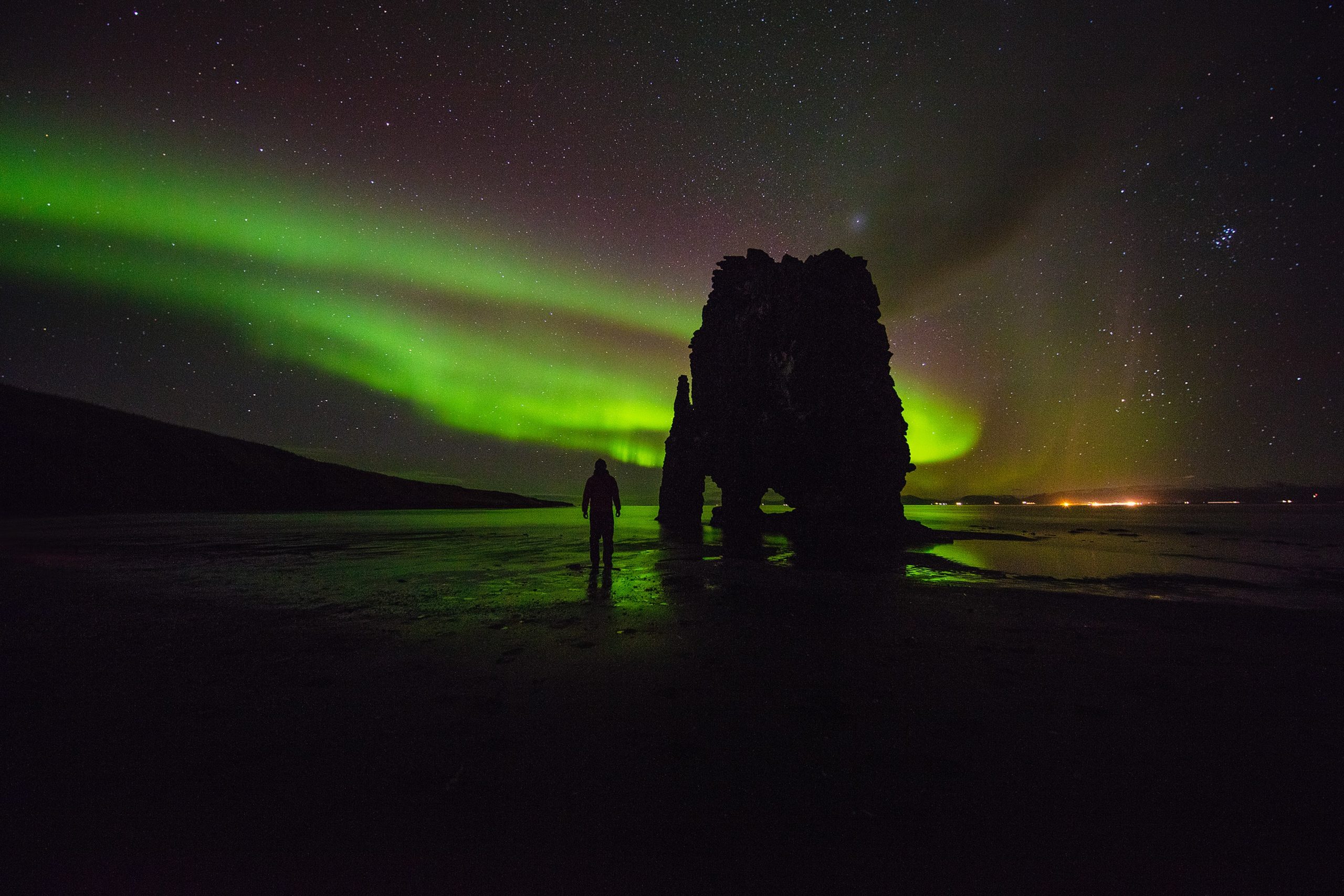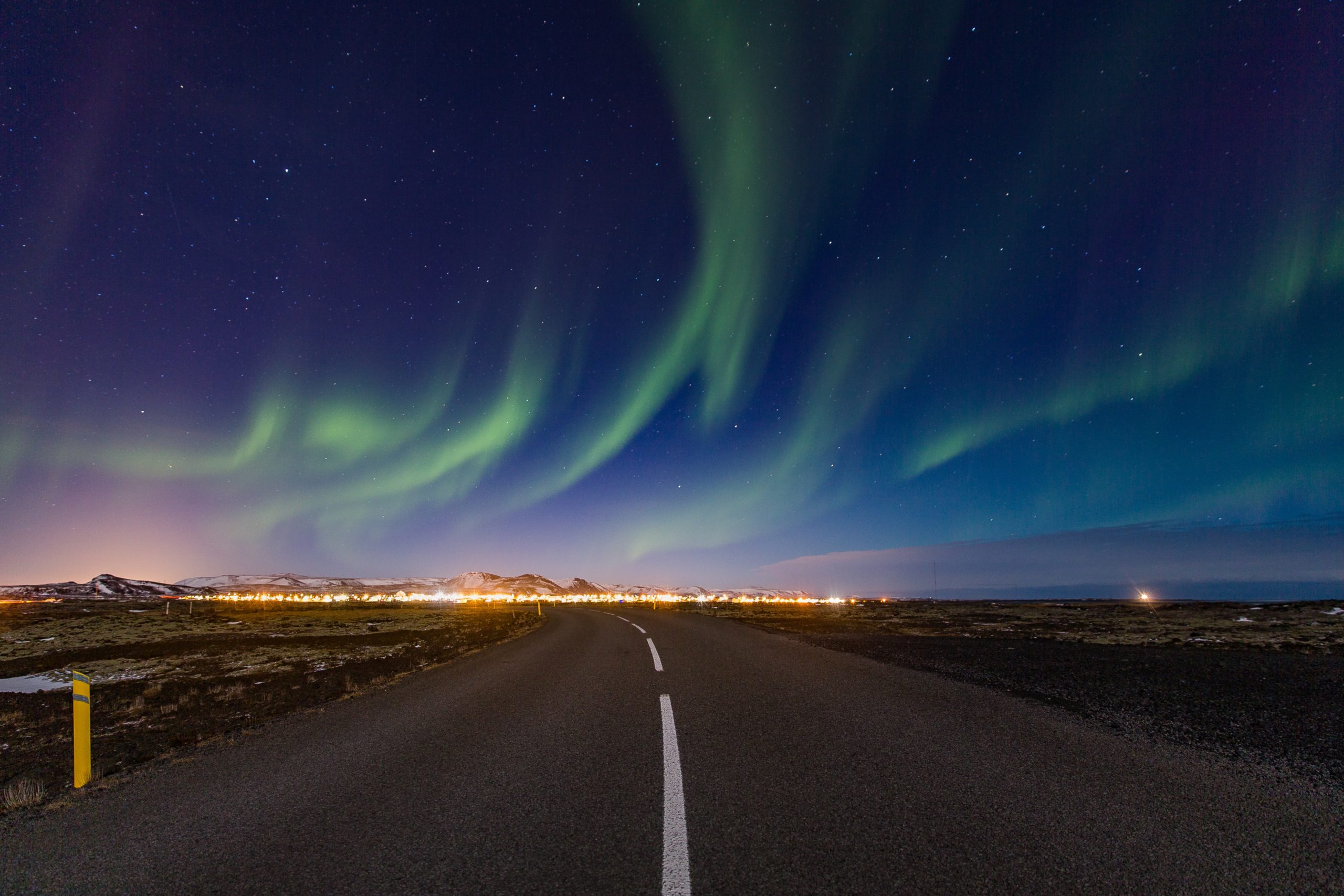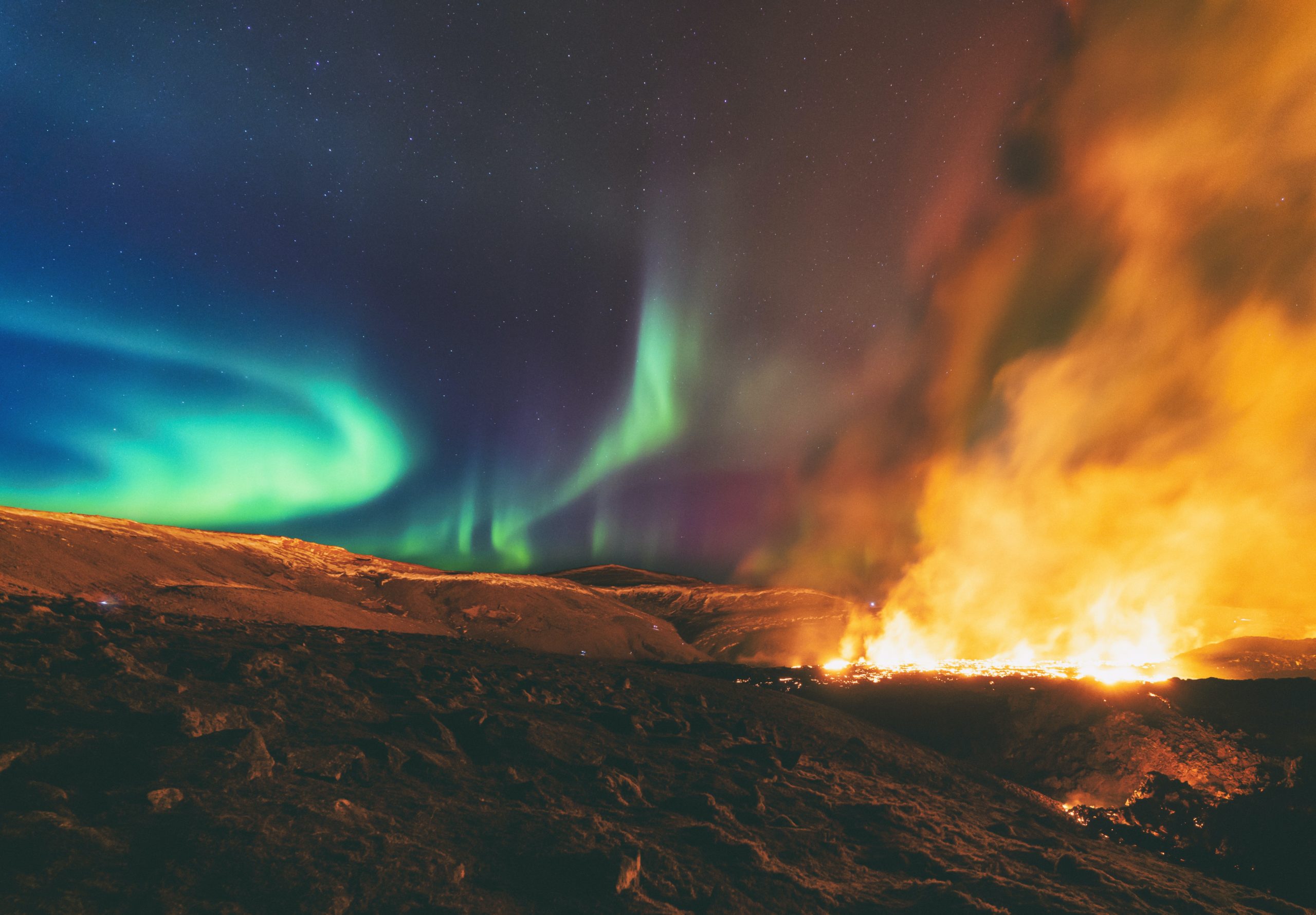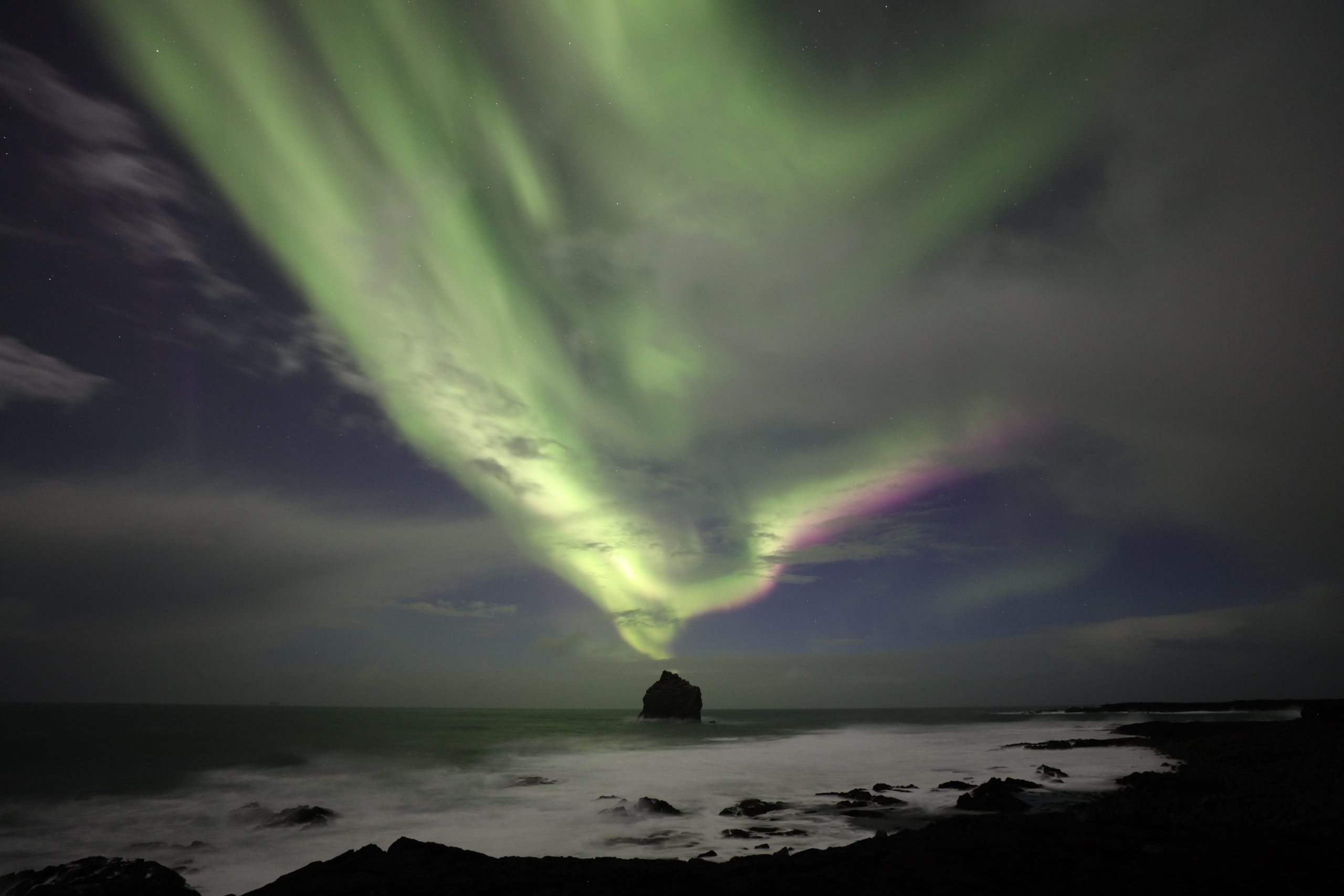"When can you see the Northern Lights in Iceland?" is the question on the tip of everyone's tongue. The minute you step off the plane in the land of fire and ice, it's time to start looking up. Or is it?
What are the Northern Lights?
Before we get to the “When can you see the Northern Lights in Iceland?” half of the show, let’s talk about what we’re actually looking for. In a country of natural wonders, the Northern Lights are one of Iceland’s greatest treasures. A phenomenon based on volatile space weather, the Aurora Borealis happens when solar activity from the sun travels over our planet and collides with our magnetosphere. This meeting of forces gives some of the super-charged gas in the solar storm an opportunity to travel down the magnetic field towards the poles, creating another collision with oxygen and nitrogen pockets in our atmosphere.
This clash creates the colorful visual byproduct of the aurora- an accidental gift of the cosmos. Because this is a polar occurrence, it takes incredible strength for the storm to grow large enough to travel closer to the equator from the pole, which is why we primarily see the aurora in very northern or southern lands.
Every so often we get lucky, and the sun sends a sizeable storm, giving us the rare chance to view the Northern Lights from places like North America and continental Europe.

Life under the polar light cycle: Choosing the right half of the year
Planning a northern lights vacation can be challenging, as nature tends to run on its own schedule. A good place to start, is to know which half of the year is aurora season in Iceland.
Because polar lights happen far above us in space, it is possible for them to occur at any time of year. Many people mistakenly think that they are related to cold weather, but, luckily this is not the case. Because of how the Earth tilts in its orbital path, the winter season in countries around the northern pole coincides with shorter days. You may have a similar light cycle situation during winter in your home country.
In a country closer to the pole, this light cycle is a bit more exaggerated and can result in days where the sun does not rise for a period of time. Iceland’s winter light cycle is not quite as extreme, but due to this trade-off, we experience a surplus of daylight hours in the summer and a surplus of dark hours in the winter.
This means that in the summer, it is much too bright for us to pick out auroral activity in the skies. There may be solar activity and auroras happening, but we would be unable to see them. Despite their appearance, we require solid darkness to view an aurora from Earth. (If you’re riding along on the International Space Station, however, you might be one of the few people that could view a July aurora!)
But for those of us down here planetside, we must wait for optimal darkness to be able to pick out auroral activity with the naked human eye.
The Northern Lights occur at a low lumen, so sometimes even a weak occurrence can be hard to pick out in perfect conditions. (A good camera can help you out with this, as the camera’s vision capabilities are not quite so limited in darkness.)
Fortunately, this extreme light cycle buys you an entire half of the year to plan a Northern Lights holiday in Iceland- which gives you more time than you might think.

August to April: The Auroral Season
Because of this light cycle, the Northern Lights season in Iceland runs from August to April. August is very early in the season, and typically we access amenable darkness by the end of the first week. However, if you are planning a vacation, it is recommended to wait until the end of August for optimal conditions.
The end of the first week of August is the earliest we have seen an aurora, but it is not generally expected and would be a risky time to plan a trip. In recent years, tours have started mobilizing for their aurora seasons at the middle to end of August, with some starting as late as September.
This August to November time frame puts you in our autumn season. Not a time typically associated with auroral viewing, the transitional seasons like fall and spring are phenomenal times to hunt for Northern Lights. These are moments in the year where colorful changes are occurring in the countryside, and often, low traffic among visitors.
These are some of our favorite times to look for aurorae, particularly because there is milder weather, manageable light for other outdoor activities, and gorgeous scenery. As you can see, the auroral season runs all the way to April. In Iceland, April is traditionally considered the beginning of the summer season (if you can believe it), so the same rules that apply to August apply here.
If you are interested in a spring aurora hunt, you will want to be careful of booking too close to April, as mid-April is too bright for aurora viewing typically. In a lucky year, professional photographers have managed to grab some surprising shots throughout April, but this would not be advisable for someone that is planning an aurora trip.
The month of March is often quite good throughout, weather permitting, and people have been known to get lucky in the very beginning of April. Once we near the middle of April, the island moves over to summertime in earnest, and the midnight sun begins to return.
This gives you quite a spectrum of time to hunt for auroras, and this season spans autumn, winter, and even spring. This means that you can tie your aurora aspirations together with additional activities, like horseback riding, hiking, ice caving, or even skiing.

"Hello darkness my old friend": Aurora watching under the cover of night
You’ve got an entire half of the year to plan your trip in, but what time does the aurora show up? This is another popular question, and the answer does change a bit depending on the time of year that you visit. For folks visiting earlier or later in the season closer to autumn and spring, you’ll find that there are fewer dark hours available for hunting.
In Iceland, you are losing or gaining minutes of light every day, depending on if you are moving away or towards midsummer or midwinter. If you’re visiting us before December, you will be losing 3-4 minutes of daylight on average every day.
After midwinter, you start to gain those minutes of daylight back. If you stay with us for a week, you might even notice a difference by the end of it! Because of this, you will find that guided experiences start a bit earlier (closer to 8:00 PM) in the autumn and spring, and a bit later 9:00-10:00 PM) in the winter months.
Like all aurora figuring, this can vary on the occurrence itself. A powerful solar storm may cause a brighter visual manifestation, thus making it possible to view earlier in the evening. However, despite the fact that you’re watching in the correct half of the year, we still require this high-quality nighttime darkness for visibility.
This can be a confusing detail, especially if you’re visiting us in December when the sunrise is closer to 11:00 AM and the sunset is nearly 3:00 PM! One might think, “If the sun has set by 4:00 PM, why can’t I see the aurora already? Isn’t it night?” Despite the early setting of the sun, we do still cycle through steps of “twilight”, or “dusk”.
You may be familiar with this if you enjoy maritime sports or navigational pursuits like flying or sailing. So despite all this extra darkness in the high point of winter, we still wait for proper nighttime in the later evening. Averages for optimal visibility may vary per person, but typically we can expect that on a good night our window will be around 10:00 PM to 1:00 AM.
Can an aurora happen outside of this time frame? Absolutely! On a phenomenal night, you might catch one at 8:00 PM! And likewise at 3:00 AM! The excitement of this phenomenon is that no two aurorae are ever the same- and neither are the experiences that lead you to them.
Like many sciences, very few things are permanently definite- so if you feel that you have exceptional darkness, clear skies, and a forecast indicating solar activity, have a look! These things do tend to sneak up on you when you least expect them.

The right place at the right time
So you’ve got an idea of when the Northern Lights can be seen in Iceland, but where should you go? Where can you see Northern Lights in Iceland? The truth is, there is no singular good spot.
This is lucky for us in a way because it means we’ve all got a fair shot, no matter where in Iceland we’re watching from. As far as darkness goes, it is advisable to move away from light pollution if you can. The greatest centers of light pollution in Iceland are still manageable enough for auroral viewing, and won’t impede you to the level of a massive metropolis- but if you can find yourself a patch of true dark your vision will adjust better and your viewing experience will be improved.
Watching near a streetlight or a house can make low light photography a bit harder to balance, and it can also cause your eyes to struggle with adjusting to their own night vision. When viewing a similar auroral occurrence, people in a brighter area may report seeing less of the aurora, or a dimmer or less vibrant color.
In a truly dark place, your eyes will be able to pick up some of the finer pieces and “shards” of the occurrence, and typically be more successful at discerning the color.
If you’ve got a camera, don’t forget to snap a few low light shots- you’d be surprised how much better the camera’s “eye” sees compared to our own! When looking for a good spot to wait for the Northern Lights, you’ll want to consider cloud cover. On an auroral forecast, you can see that the cloud map is an integral part of finding out if you’ll be able to view activity or not.
Because the Northern Lights happen above our weather system, we miss out on any light shows that happen on cloudy evenings. The good news about this is that cloud systems can move quickly over us on a windy night, not all areas will have the same weather, and even forecasts miss tiny windows of clarity in the sky.

Sometimes these holes in the cloud layer are all we need to glimpse the glow- but many great activity nights have been canceled over a thick layer of cloud cover. If you’re in a vehicle and you’re able, it can be helpful to watch the forecast to see where areas of clarity may be located.
If there are clear skies around your location, you can head in the general direction of that clarity. In fact, many guided experiences will do a similar thing and will plot their course that night based on where the clarity is expected to be.
This is the best way to choose a spot, and the travel time that you spend on the way to the clear skies may also prove lucky. Covering ground and exposing yourself to different areas of the sky can be helpful since a large portion of aurora hunting is the waiting.
The longer you’re out in the dark under clear skies, the better your chances are. Because of the importance of clouds in this equation, it can sometimes mean just heading out on the road that leads in that direction. If you’re interested in finding a spot to wait in, we recommend looking for landmarks of natural importance along the way, or national parks.
Parks can be a great spot to watch from because they are designed for spectating and parking your car safely (unlike the side of the road), but be warned that many others may have the same idea. Be careful not to pull over to stop your vehicle in an unsafe location to watch! Country roads can be dark and narrow, and they do not always have a shoulder for pulling over.
It’s exciting when an aurora happens upon you in the car, but being safe and waiting for an approved pull-over location is the safest way to enjoy this gift of nature.
However, you don’t always have to be on the road to catch the Northern Lights! There are a few spectacular hideaways in Iceland just for this very purpose, where you can be cozy, alone in nature, and waiting in a perfect dark location.
For those that want to try the most comfortable hunt around, we recommend the Northern Lights igloo. Lay back on a down comforter in a heated bubble and have a drink? We can hardly think of a better way to spend the night. (Or a better photo op!)
